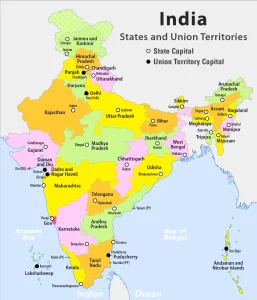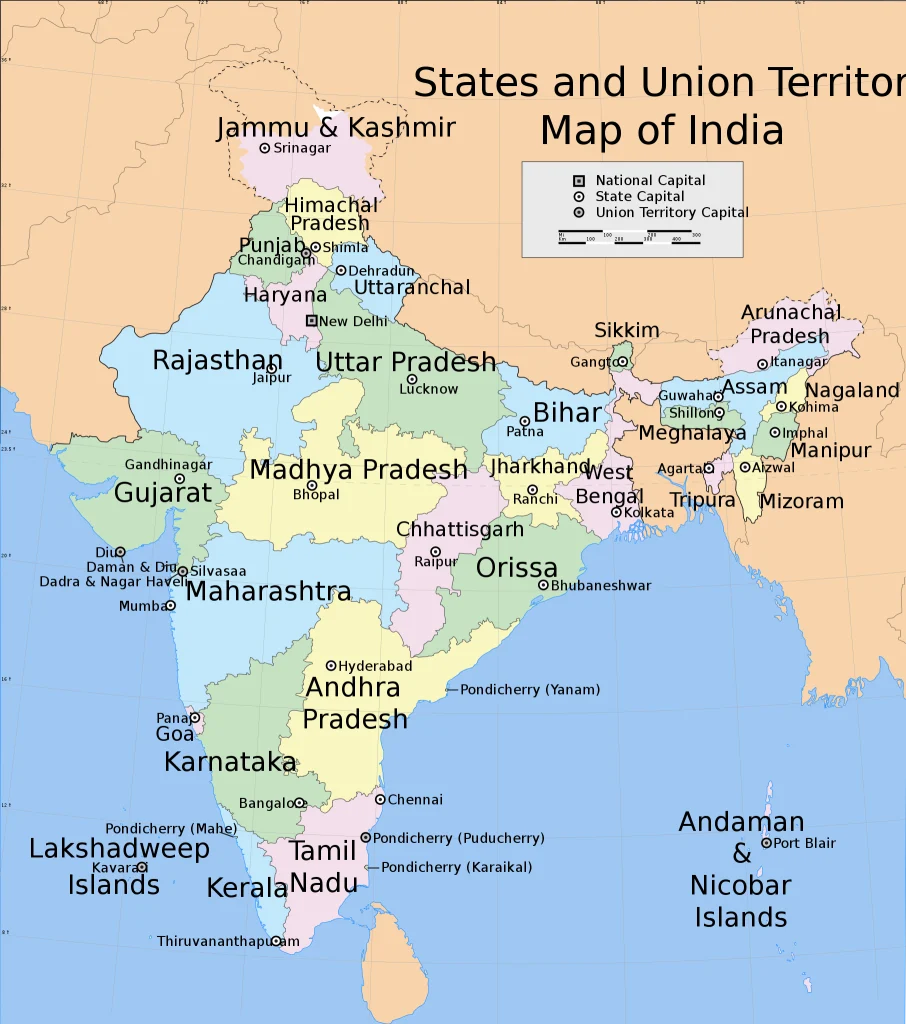Located in South Asia, the vast and culturally diverse nation of India is known for its varied landscapes and historic past. By both population and land area, it ranks as the seventh biggest country in the world.
Pakistan, China, Nepal, Bhutan, Bangladesh, and Myanmar are some of India’s neighboring countries. The Indian Ocean forms its southern boundary. Each one of the twenty-eight states and eight union territories has its own government, but the nation as a whole is run by a federal government.
In this article you will get to know about the States and Capitals of India as per 2024.
States and Capitals of India:
India, being an extensive and diversified country, is politically divided into 28 states and 8 union territories. Every state in India is ruled from a capital city where its primary administrative, legislative, and judicial operations are focused. Within certain states, these three duties are combined into a single capital city. The Chief Minister is the leader of each state’s government. The information on this site is a current overview of the states and union territories of India, including their distinct capitals, providing a thorough guide to the political and administrative structure of the country.
Here is a Complete List of States and Capitals of India:
| State/Union Territory | Capital |
| Andhra Pradesh | Amaravati |
| Arunachal Pradesh | Itanagar |
| Assam | Dispur |
| Bihar | Patna |
| Chhattisgarh | Raipur |
| Goa | Panaji |
| Gujarat | Gandhinagar |
| Haryana | Chandigarh |
| Himachal Pradesh | Shimla |
| Jharkhand | Ranchi |
| Karnataka | Bangalore |
| Kerala | Thiruvananthapuram |
| Madhya Pradesh | Bhopal |
| Maharashtra | Mumbai |
| Manipur | Imphal |
| Meghalaya | Shillong |
| Mizoram | Aizawl |
| Nagaland | Kohima |
| Odisha | Bhubaneswar |
| Punjab | Chandigarh |
| Rajasthan | Jaipur |
| Sikkim | Gangtok |
| Tamil Nadu | Chennai |
| Telangana | Hyderabad |
| Tripura | Agartala |
| Uttar Pradesh | Lucknow |
| Uttarakhand | Dehradun |
| West Bengal | Kolkata |
| Union Territories | Capitals |
| Jammu & Kashmir
Andaman and Nicobar Islands |
Srinagar (Summer)
Jammu ( Winter) Port Blair |
| Chandigarh | Chandigarh |
| Dadra and Nagar Haveli and Daman and Diu | Daman |
| Lakshadweep | Kavaratti |
| Delhi | New Delhi |
| Puducherry | Puducherry |
| Ladakh | Leh |
This table includes all 28 States and Capitals of India and 8 union territories along with their respective capitals.
Read More : Prime Ministers of India List from 1947 to 2024

Let’s have a brief look at each of 28 States and Capitals of India, highlighting their unique features and specialties:
1. Andhra Pradesh – Known for its rich history, including the remains of the ancient empire of Vijayanagara in Hampi. It is a major rice producer, with a significant IT industry in Hyderabad.
2. Arunachal Pradesh -Known for its natural beauty and as the “Land of the Dawn-Lit Mountains.” It is culturally diverse, including an extensive Buddhist community.
3. Assam – Known for its Assam tea and silk. Kaziranga National Park, a UNESCO World Heritage Site, is home to two-thirds of the world’s great one-horned rhinoceros.
4. Bihar- Known for ancient universities like as Nalanda and Vikramashila. It is popular in Indian history and spirituality, including many Buddhist shrines.
5. Chhattisgarh – Famous for its steel manufacturing and big tribal population. It is rich in natural resources and well-known for the Chitrakote Waterfalls.
6. Goa- is known for its beaches, Portuguese heritage, and active nightlife.
7. Gujarat– is home to the Asian Lion in Gir Forest. It is an economic powerhouse, particularly in textiles and petrochemicals.
8. Haryana – Well-known for its contributions to agriculture, particularly wheat and dairy products. It also provides a strong IT and automobile sector.
9. Himachal Pradesh – Renowned for its hill stations and charming elegance. It’s a popular destination for trekking and mountain sports.
10. Jharkhand– Jharkhand is mineral-rich and crucial to India’s industrial activity. It is also noted for its waterfalls and wildlife refuges.
11. Karnataka-is home to Bangalore’s IT hub. It has numerous cultural heritage sites, including as Hampi and Mysore.
12. Kerala is known for its backwaters, Ayurvedic treatments, and high human development indexes.
13. Madhya Pradesh – Known as the “Heart of India,” it is famous for wildlife reserves such as Bandhavgarh and Kanha.
14. Maharashtra – India’s financial center, home to Bollywood, and known for the Ajanta and Ellora caves.
15. Manipur– Famous for its ancient dance style Manipuri and sports fans, particularly in polo and football.
16. Meghalaya – Known for its abundant rainfall and live root bridges. It is culturally different from a matrilineal community.
17. Mizoram-is known for its spectacular landscape and bamboo woods. It boasts a high literacy rate and a harmonious society.
18. Nagaland is known for its indigenous tribes and the Hornbill Festival, which celebrates the country’s unique culture and traditions.
19. Odisha -Known for its temples, such as the Jagannath Temple in Puri, as well as its unique dance traditions, including Odissi.
20. Punjab -Renowned for its agricultural produce, colorful culture, and the Golden Temple in Amritsar.
21. Rajasthan – Known for its deserts, palaces, and arts. The tourist and craft industries are significant.
22. Sikkim – Sikkim is known for its biodiversity and being India’s first organic state. It is also home to India’s highest peak, Kanchenjunga.
23. Tamil Nadu – Known for its Dravidian-style Hindu temples and as a manufacturing and technological powerhouse.
24. Telangana – Founded in 2014 from the northwestern region of Andhra Pradesh, Telangana is known for its IT and biotech industries.
25. Tripura – A culturally and historically rich region with a mix of tribal and Bengali cultures. It is renowned for its bamboo goods and palaces.
26. Uttar Pradesh – Home of the Taj Mahal and a large population hub. It shares religious significance with cities like as Varanasi and Ayodhya.
27. Uttarakhand – Known for its Hindu holy places and natural splendor, such as the Himalayas and the Ganga and Yamuna rivers.
28. West Bengal – Famous for its artistic contributions, including literature and cinema, as well as festivals such as Durga Puja.
These highlights offer a look into the diverse and rich fabric that comprises the States and Capitals of India, each contributing significantly to the country’s identity.
Here are some unique Facts about States and Capitals of India:
- Andhra Pradesh (Amaravati) is the administrative capital, although (Hyderabad) remains the de facto capital until 2024.
- Arunachal Pradesh (Itanagar) is known for its rich tribal culture and gorgeous landscapes.
- Assam( Dispur), an area of Guwahati, is the administrative capital.
- Bihar (Patna) is one of the world’s oldest constantly populated places.
- Chhattisgarh (Raipur) is a significant commercial hub in central India.
- Goa (Panaji) is a lovely city with Portuguese colonial past.
- Gujarat (Gandhinagar) is a planned modern city with plenty of green space.
- Haryana (Chandigarh) is the capital of both Haryana and Punjab.
- Himachal Pradesh (Shimla), famous for its Victorian architecture and mountainous landscape.
- Jharkhand(Ranchi) is bordered by rich mineral bounty and forested areas.
- Karnataka (Bengaluru), the leading IT powerhouse called the “Silicon Valley of India.”
- Kerala (Thiruvananthapuram), known for its uneven topography of low coastal hills.
- Madhya Pradesh (Bhopal) has two distinct cityscapes (Old and New Bhopal).
- Maharashtra (Mumbai) is the financial, commercial, and entertainment hub of India.
- Manipur (Imphal) is known for its gorgeous landscapes and cultural heritage.
- Meghalaya (Shillong), known as the “Scotland of the East” because of its beautiful hills and peaks.
- Mizoram (Aizawl), located on slopes of steep hills and recognized for its excellent climate.
- Nagaland (Kohima), known for its historical significance during the Second World War.
- Odisha (Bhubaneswar) is regarded as the “Temple City of India” because to its ancient temples.
- Punjab (Chandigarh) is a well-planned city famous for its modern architecture and design.
- Rajasthan (Jaipur), also known as the “Pink City,” is known for its royal palaces and lively festivals.
- Sikkim (Gangtok) is known for its natural beauty and views of the Himalayas.
- Tamil Nadu (Chennai) is a cultural and economic powerhouse with a large automobile sector.
- Telangana (Hyderabad) is a major technology industry hub with a rich history and culinary culture.
- Tripura (Agartala) is renowned for its varied culture and royal history.
- Uttar Pradesh (Lucknow) is renowned for its sophisticated manners, gorgeous gardens, poetry, music, and delicious food.
- Uttarakhand (Dehradun), enclosed in the Himalayan foothills, with the Garhwal Himalayas as a backdrop.
- West Bengal (Kolkata), India’s cultural capital, is famous for colonial architecture, festivals, and the arts.
These states and capitals of India are more than just administrative headquarters; they are vibrant, diversified, and historically significant, with each contributing differently to India’s fabric.

India is a diversified and geographically vast country split politically into 28 states and eight Union territories, each with its own capital. Here are some key points regarding States and Capitals of India:
- Federal Structure: India’s states and Union territories are the primary administrative divisions. Each state has its own government, while Union territories are directly managed by the Central Government.
- Cultural Diversity: Each state and territory has its own distinct culture, language, and traditions, which add to India’s rich diversity. Capital cities frequently represent the region’s cultural diversity and historical significance.
- Economic Hubs: Several of India’s capital cities serve as major economic centers. For example, Mumbai is Maharashtra’s city and a significant financial and entertainment center, while Bangalore, Karnataka’s capital, is known as India’s Silicon Valley due to its strong IT industry.
- Political Centers: India’s capital, New Delhi, is home to all three branches of the Indian government. It houses the President’s residence, Parliament House, and the Supreme Court of India.
- Tourism and Heritage: Many capitals are attractive tourist destinations because of their historical sites, museums, and cultural festivals. Jaipur (Rajasthan), Bhubaneswar (Odisha), and Lucknow (Uttar Pradesh) are prominent examples.
- Educational Centers: Capitals such as Kolkata (West Bengal), Chennai (Tamil Nadu), and Hyderabad (Telangana) are home to some of India’s most prestigious educational institutions and colleges, attracting students from all across the country and beyond.
- Geographical Significance: Capitals are frequently placed strategically to ensure successful management and administration of their respective governments. For example, Dispur, Assam’s capital, is a significant city in northeastern India.
- Changing Capitals: Some states are planning to change or have already changed their capitals for a variety of reasons. Andhra Pradesh, for example, is creating Amaravati as its new capital, while Visakhapatnam serves as the state’s current administrative capital.
These points highlight the roles and importance of the States and Capitals of India and Union territories, which reflect the country’s geopolitical, cultural, and historical landscapes.
Read More : Top 10 Female Entrepreneurs In India



